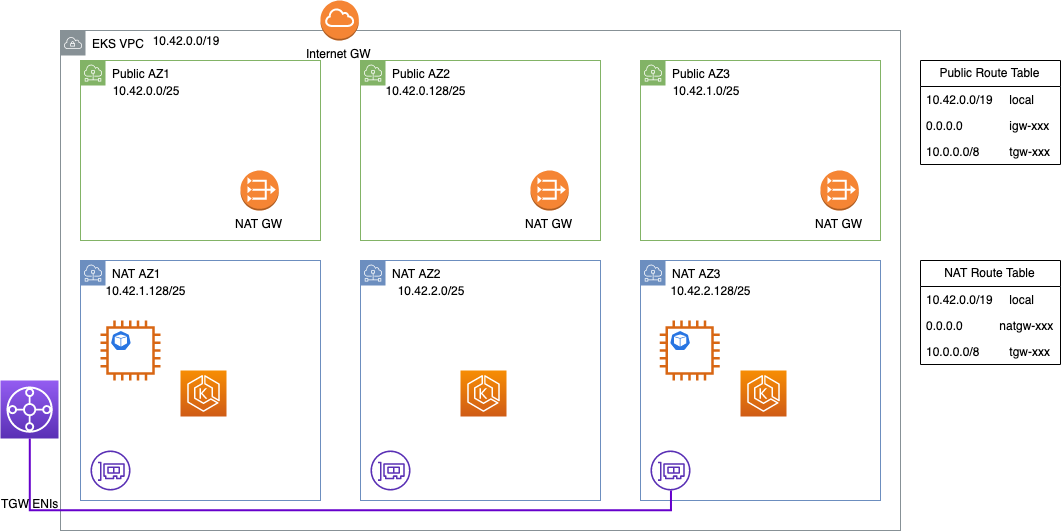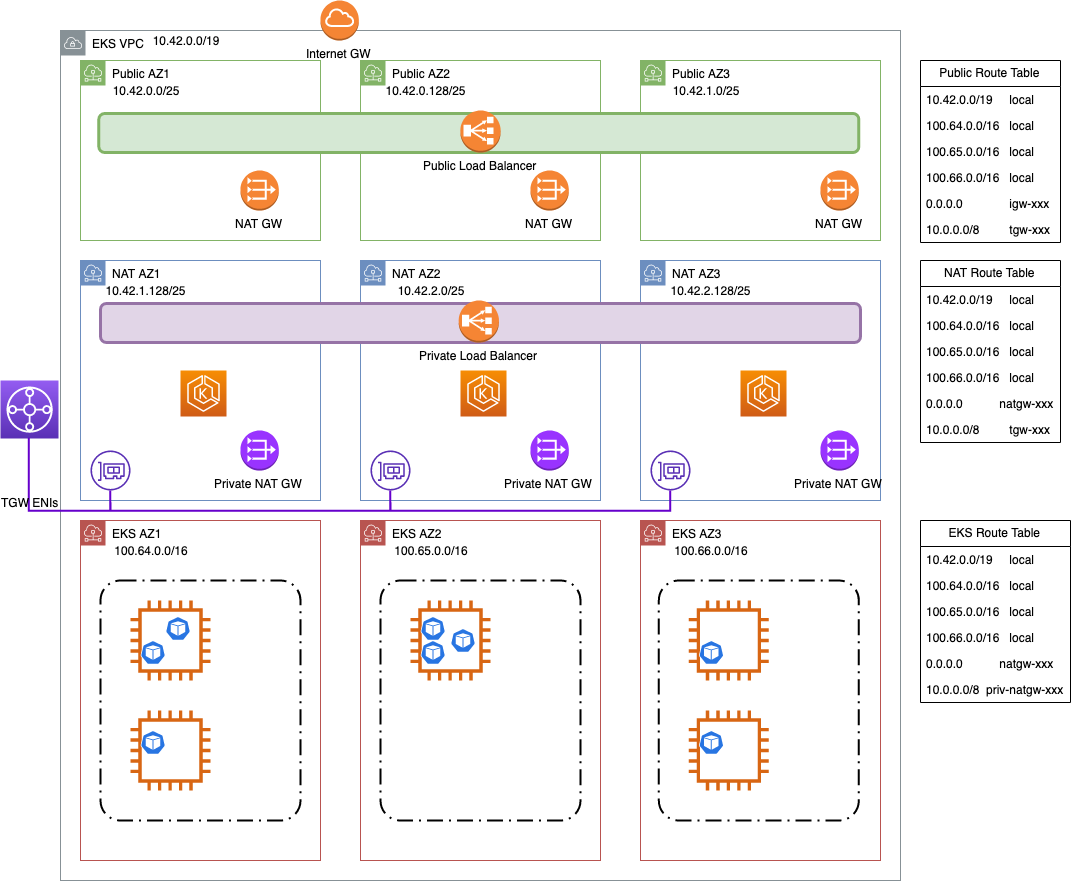Networking for AI
VPC and IP Considerations
Plan for a large amount of IP address usage in your EKS clusters.
The AWS VPC CNI maintains a “warm pool” of IP addresses on the EKS worker nodes to assign to Pods. When more IP addresses are needed for your Pods, the CNI must communicate with EC2 APIs to assign the addresses to your nodes. During periods of high churn or large scale out these EC2 API calls can be rate throttled, which will delay the provisioning of Pods and thus delay the execution of workloads. When designing the VPC for your environment plan for more IP addresses than just your pods to accommodate this warm pool.
With the default VPC CNI configuration larger nodes will consume more IP addresses. For example a
m5.8xlarge node that is running
10 pods will hold 60 IPs total (to satisfy WARM_ENI=1). A m5.16xlarge node would hold 100 IPs. Configuring the VPC
CNI to minimize this warm pool can increase the EC2 API calls from your nodes and increase the risk of rate throttling.
Planning for this extra IP address usage can avoid rate throttling problems and managing the IP address usage.
Consider using a secondary CIDR if your IP space is constrained.
If you are working with a network that spans multiple connected VPCs or sites the routable address space may be limited.
For example, your VPC may be limited to small subnets like below. In this VPC we wouldn’t be able to run more than one
m5.16xlarge node without adjusting the CNI configuration.

You can add additional VPC CIDRs from a range that is not routable across VPCs (such as the RFC 6598 range,
100.64.0.0/10). In this case we added 100.64.0.0/16, 100.65.0.0/16, and 100.66.0.0/16 to the VPC (as this is the
maximum CIDR size), then created new subnets with those CIDRs. We recreated the node groups in the new subnets, leaving
the existing EKS cluster control plane in place.

With this configuration you can still communicate with the EKS cluster control plane from connected VPCs but your nodes and pods have plenty of IP addresses to accommodate your workloads and the warm pool.
Tuning the VPC CNI
VPC CNI and EC2 Rate Throttling
When an EKS worker node is launched it initially has a single ENI with a single IP address attached for the EC2 instance to communicate. As the VPC CNI launches it tries to provision a Warm Pool of IP addresses that can be assigned to Kubernetes Pods (More details in the EKS Best Practices Guide).
The VPC CNI must make AWS EC2 API calls (like AssignPrivateIpV4Address and DescribeNetworkInterfaces) to assign
those additional IPs and ENIs to the worker node. When the EKS cluster scales out the number of Nodes or Pods there
could be a spike in the number of these EC2 API calls. This surge of calls could encounter rate throttling from the EC2
API to help the performance of the service, and to ensure fair usage for all Amazon EC2 customers. This rate throttling
can cause the pool of IP address to be exhausted while the CNI tries to allocate more IPs.
These failures will cause errors like the one below, indicating that the provisioning of the container network namespace has failed because the VPC CNI could not provision an IP address.
Failed to create pod sandbox: rpc error: code = Unknown desc = failed to set up sandbox container "xxxxxxxxxxxxxxxxxxxxxx" network for pod "test-pod": networkPlugin cni failed to set up pod test-pod_default" network: add cmd: failed to assign an IP address to container
This failure delays the launch of the Pod and adds pressure to the kubelet and worker node as this action is retried until the IP address is assigned. To avoid this delay you can configure the CNI to reduce the number of EC2 API calls needed.
Avoid using WARM_IP_TARGET in large clusters, or cluster with a lot of churn
WARM_IP_TARGET can help limit the “wasted” IPs for small clusters, or clusters that has very low pod churn. However,
this environment variable on the VPC CNI needs to be carefully configured in large clusters as it may increase the
number of EC2 API calls, increasing the risk and impact of rate throttling.
For clusters that have a lot of Pod churn, it is recommended to set MINIMUM_IP_TARGET to a value slightly higher than
the expected number of pods you plan to run on each node. This will allow the CNI to provision all of those IP addresses
in a single (or few) calls.
[...
]
# EKS Addons
cluster_addons = {
vpc-cni = {
configuration_values = jsonencode({
env = {
MINIMUM_IP_TARGET = "30"
}
})
}
}
[...]
Limit the number of IPs per node on large instance types with MAX_ENI and max-pods
When using larger instance types such as 16xlarge or 24xlarge
the number of IP addresses that can be assigned per ENI
can be fairly large. For example, a c5.18xlarge instance type with the default CNI configuration of WARM_ENI=1 would
end up holding 100 IP addresses (50 IPs per ENI * 2 ENIs) when running a handful of pods.
For some workloads the CPU, Memory, or other resource will limit the number of Pods on that c5.18xlarge before we need
more than 50 IPs. In this case you may want to be able to run 30-40 pods maximum on that instance.
[...
]
# EKS Addons
cluster_addons = {
vpc-cni = {
configuration_values = jsonencode({
env = {
MAX_ENI = "1"
}
})
}
}
[...]
Setting the MAX_ENI=1 option on the CNI and that this will limit the number of IP addresses each node is able to
provision, but it does not limit the number of pod that kubernetes will try to schedule to the nodes. This can lead to a
situation where pods are scheduled to nodes that are unable to provision more IP addresses.
To limit the IPs and stop k8s from scheduling too many pods you will need to:
- Update the CNI configuration environment variables to set
MAX_ENI=1 - Update the
--max-podsoption for the kubelet on the worker nodes.
To configure the --max-pods option you can update the userdata for your worker nodes to set this option via the --kubelet -extra-args in the bootstrap.sh script. This script configures the max-pods value for the kubelet, the --use-max-pods false` option disables this behavior when providing your own value:
eks_managed_node_groups = {
system = {
instance_types = ["m5.xlarge"]
min_size = 0
max_size = 5
desired_size = 3
pre_bootstrap_user_data = <<-EOT
EOT
bootstrap_extra_args = "--use-max-pods false --kubelet-extra-args '--max-pods=<your_value>'"
}
One problem is the number of IPs per ENI is different based on the Instance type (for example a
m5d.2xlarge can have 15 IPs per ENI, where a
m5d.4xlarge can hold 30 IPs per ENI).
This means hard-coding a value for max-pods may cause problems if you change instance types or in mixed-instance
environments.
In the EKS Optimized AMI releases there
is a script included that can be used to help calculate the AWS Recommended max-pods value.
If you’d like to automate this calculation for mixed instances you will also need to update the userdata for your
instances to use the --instance-type-from-imds flag to autodiscover the instance type from instance metadata.
eks_managed_node_groups = {
system = {
instance_types = ["m5.xlarge"]
min_size = 0
max_size = 5
desired_size = 3
pre_bootstrap_user_data = <<-EOT
/etc/eks/max-pod-calc.sh --instance-type-from-imds —cni-version 1.13.4 —cni-max-eni 1
EOT
bootstrap_extra_args = "--use-max-pods false --kubelet-extra-args '--max-pods=<your_value>'"
}
Maxpods with Karpenter
By default, Nodes provisioned by Karpenter will have the max pods on a
node based on the node instance type. To
configure the --max-pods option as mentioned above by defining at the Provisioner level by specifying maxPods within
the .spec.kubeletConfiguration . This value will be used during Karpenter pod scheduling and passed through to
--max-pods on kubelet startup.
Below is the example Provisioner spec:
apiVersion: karpenter.sh/v1alpha5
kind: Provisioner
metadata:
name: default
spec:
providerRef:
name: default
requirements:
- key: "karpenter.k8s.aws/instance-category"
operator: In
values: [ "c", "m", "r" ]
- key: "karpenter.sh/capacity-type" # If not included, the webhook for the AWS cloud provider will default to on-demand
operator: In
values: [ "spot", "on-demand" ]
# Karpenter provides the ability to specify a few additional Kubelet args.
# These are all optional and provide support for additional customization and use cases.
kubeletConfiguration:
maxPods: 30
Application
DNS Lookups and ndots
In Kubernetes Pods with the default DNS configuration
have a resolv.conf file like so:
nameserver 10.100.0.10
search namespace.svc.cluster.local svc.cluster.local cluster.local ec2.internal
options ndots:5
The domain names listed in the search line are appended to DNS names that are not fully qualified domain names (FQDN).
For example, if a pod tries to connect to a Kubernetes service using servicename.namespace the domains would be
appended in order until the DNS name matched the full kubernetes service name:
servicename.namespace.namespace.svc.cluster.local <--- Fails with NXDOMAIN
servicename.namespace.svc.cluster.local <-- Succeed
Whether a domain is fully qualified is determined by the ndots option in the resolv.conf. This option defines the
number of dots that must be in a domain name before the search domains are skipped. These additional searches can
add latency to connections to external resources like S3 and RDS endpoints.
The default ndots setting in Kubernetes is five, if your application isn’t talking to other pods in the cluster, we
can set the ndots to a low value like “2”. This is a good starting point, because it still allows your application to
do service discovery within the same namespace and in other namespaces within the cluster, but allows a domain like
s3.us-east-2.amazonaws.com to be recognized as a FQDN (skipping the search domains).
Here’s an example pod manifest from the Kubernetes documentation with ndots set to “2”:
apiVersion: v1
kind: Pod
metadata:
namespace: default
name: dns-example
spec:
containers:
- name: test
image: nginx
dnsConfig:
options:
- name: ndots
value: "2"
While setting ndots to “2” in your pod deployment is a reasonable place to start, this will not universally work in
all situations and shouldn’t be applied across the entire cluster. The ndots configuration needs to be configured at
the Pod or Deployment level. Reducing this setting at the Cluster level CoreDNS configuration is not recommended.
Inter AZ Network Optimization
Some workloads may need to exchange data between Pods in the cluster, like multi-node inference, multi node training, or multi replica inference. If the Pods are spread across multiple Availability Zones (AZs), this can turn incur extra costs from inter AZ egress. For these workloads, it is recommended to pods in the same AZ. Colocating pods in the same AZ serves two main purposes:
- Reduce inter-AZ traffic costs
- Reduce network latency between executors/Pods
To have pods co-located on the same AZ, we can use podAffinity based scheduling constraints. The scheduling constraint
preferredDuringSchedulingIgnoredDuringExecution can be enforced in the Pod spec. For example, ins Spark we can use a
custom template for our driver and executor pods:
spec:
executor:
affinity:
podAffinity:
preferredDuringSchedulingIgnoredDuringExecution:
- weight: 100
podAffinityTerm:
topologyKey: topology.kubernetes.io/zone
labelSelector:
matchLabels:
"ray.io/cluster": "ray-cluster-name"
...
You can also leverage Kubernetes Topology Aware Routing to have Kubernetes services route traffic in more efficient means once pods have been created: https://aws.amazon.com/blogs/containers/exploring-the-effect-of-topology-aware-hints-on-network-traffic-in-amazon-elastic-kubernetes-service/
Having all executors located in a single AZ, means that AZ will be a single point of failure. This is a tradeoff you should consider between lowering network cost and latency, and the event of an AZ failure interrupting workloads. If your workload is running on instances with constrained capacity you may consider using multiple AZs to avoid Insufficient Capacity errors.
If you are using the inference-charts, topology awareness is enabled by
default to increase throughput and reduce
costs. This can be disabled by setting inference.modelServer.deployment.topologySpreadConstraints.enabled: false and
inference.modelServer.deployment.podAffinity.enabled: false